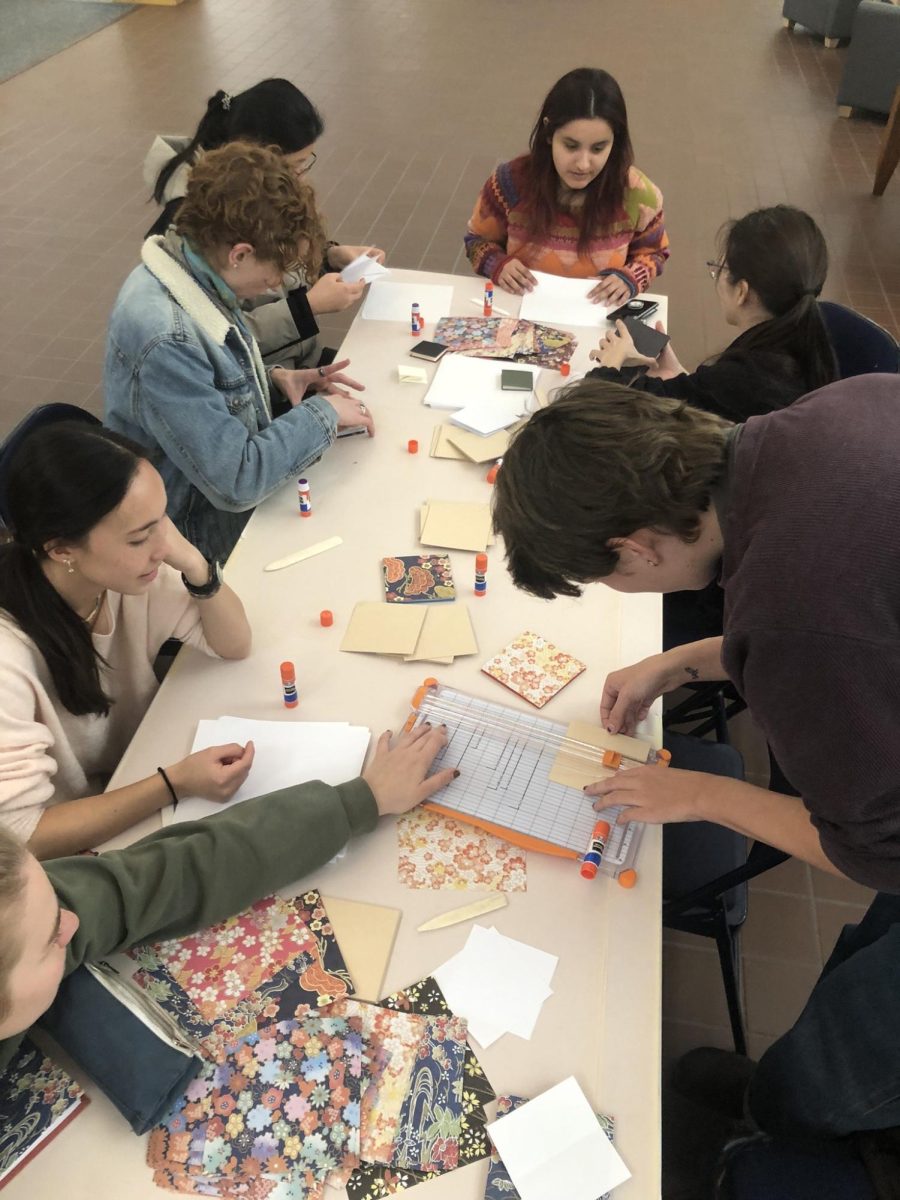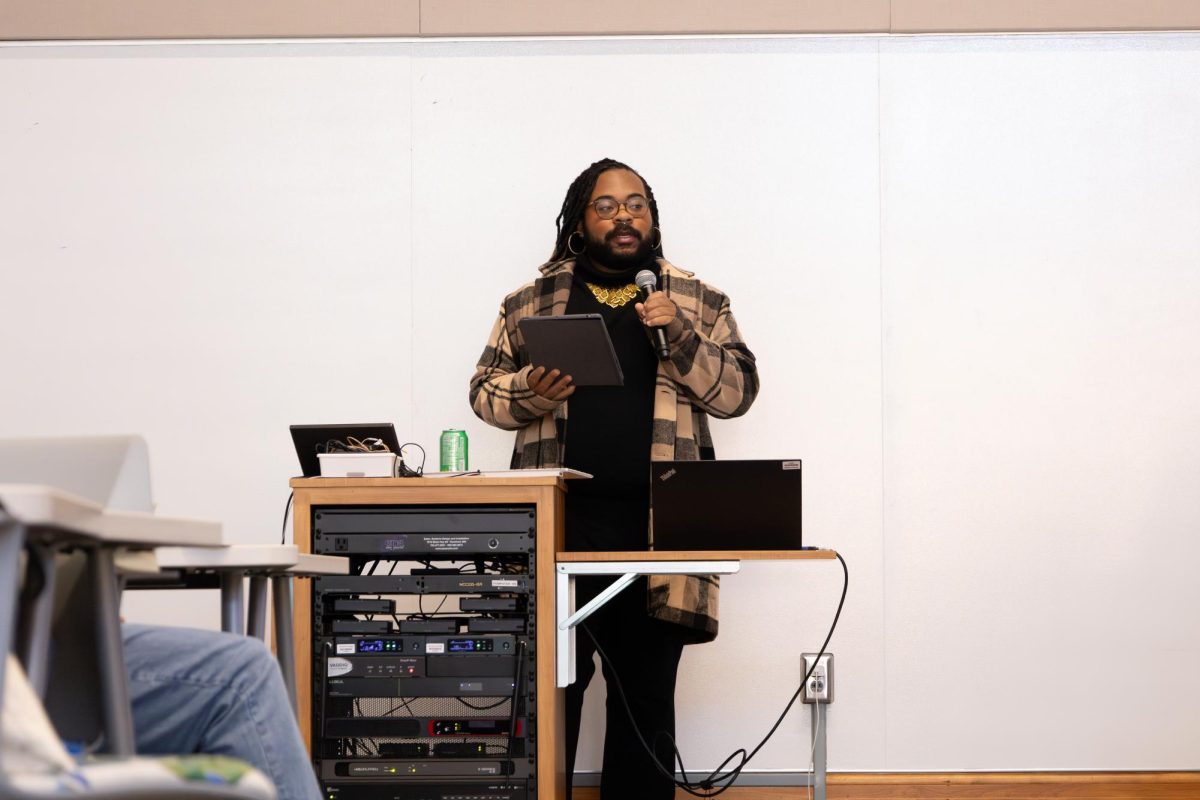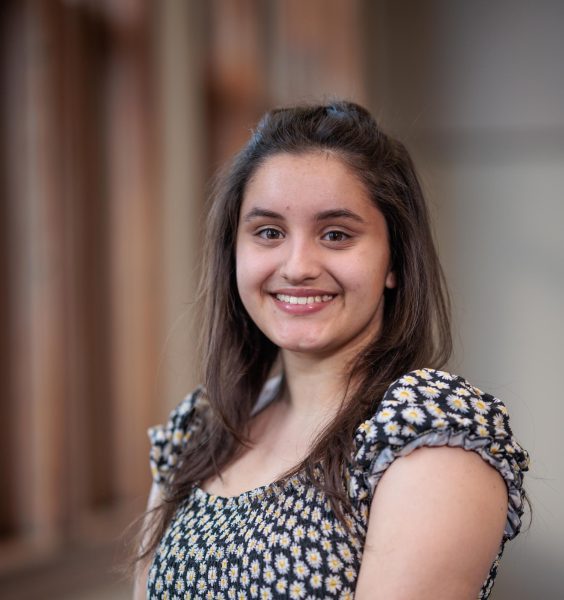On Monday, Feb. 5, the Laurence McKinley Gould Library hosted an origami book making session from 2:00-3:00 p.m. Abigail Merritt, Gould Library Conservator, led over two dozen attendees (including students, faculty and staff) through the steps of creating their very own book to take home. Planning for this event was done by Merritt and Zoe Adler, a curator for Gould library with a focus on exhibitions, and began over a month ago in early January.
As a trained book conservator, Merritt’s work consists of keeping the library’s collection in usable condition so the Carleton community can continue to enjoy the books, magazines and other physical objects in its collection. Merritt works on not only books in the library’s stacks, but books tucked away in the library’s special collections as well. “If a book is damaged, she can probably fix it! If it is not damaged, she helps it stay that way,” reads her bio. Merritt’s background in the field of book conservation lent itself to teaching guests how to create books; she even brought tools from her work — such as bone folders —to the session for guests to use.
In fact, all materials were supplied for the event, so passers-by could jump in and join the fun — no RSVP needed. One such passerby was Yifei Ren ’26, who saw the book making session while studying on fifth Libe and used the workshop as a “good study break.” Ren was particularly impressed with the selection of origami paper, commenting on how pretty the many paper options were.
This open, drop-in friendly workshop fostered a “relaxing and fun” environment that was “beginner friendly,” said Sequoia Wyckoff ’25, a student worker for the library and participant at the book making session. Adler described the atmosphere as “bubbly and happy,” with Merritt adding that there were “moments of concentration” as well. Amidst the hustle and bustle of library life, an island of calm was formed at this table situated in the Gould Library lobby.
For an hour, students were part of a brief but beautiful crafting community. Arms overlapped as crafters reached for supplies, neighbors shared tips and tricks they had learned along the way, and quips were swapped back and forth. “Community building is happening,” said Adler, “and that’s one of the things we hoped would happen.” Wyckoff echoed these sentiments, saying that she “feels like arts and crafts is the perfect thing to do with others.” The workshop was well-received by the Carleton community. Katrina Ostrom ’26, a participant in the workshop, remarked that she “would make [origami books] forever if I could, but I don’t know when this workshop will end!”
Merritt appreciated how the hands-on process of book making helped guests “conceptualize how the materials worked together.” This way of engaging people is novel in a space dominated by books: “being able to do something with your hands and see the final project is different from the type of work of reading and studying,” said Merritt. Grace Gatewood ’24, a student worker for the library who works in restoration with Merritt, built on this idea, saying, “I like working with my hands.” An appealing aspect of this method of engagement was the ability to make something tangible: “I love doing arts and crafts and making a little something makes me so happy,” said Ostrom.
This origami book making workshop was inspired by “Folded,” the current exhibit in Gould Library, supported by the Robert C. Larson ’56 Art in the Library Program. “Folded” is on display from Jan. 8 through March 12, 2024. On display are a selection of artist’s books, taken from Carleton’s special collections. The theme uniting this diverse collection was the format of these books; each artist implemented a technique called “accordion fold.” Adler shared that exhibits such as “Folded” are unique opportunities to “show people things that are typically hidden away.”
By making origami books of their own, guests were able to better understand the physical form of the works displayed in “Folded.” Adler explained that often, when viewed only in a case, accordion-fold books can seem “very complicated.” Because these works are in a case, viewers lose the ability to handle and manipulate the books as the artists intended. “But with this event, you can make one and understand the movement of the book,” said Adler.
The works displayed in “Folded” varied in almost every aspect, from subject matter to color palette to size and shape. Fernando Lopes’ “Flag book: interaction towards a better world” (1986) used the same format as the origami books taught in the workshop, with each folded side colored to represent a different country’s flag.
“These chickens,” made by David B Johnson in 2007, alternated poetry and imagery. “These chickens remind me of aristocrats—” read one panel, with the next panel depicting a stylized print of a chicken in black ink on a white background. “with their long crazy beards—” continued the next fold, followed by a chicken printed on a red background and then another on a yellow background. “and eccentric hats,” finished the poem. The book then concluded with two more prints of chickens on a purple then a yellow background.
Bonnie P. O’Connell’s work, titled “The Anti-Warhol Museum: proposals for the socially responsible disposal of Warholia,” was a small and delicate book made in the shape of a five-pointed star resembling a museum with miniature artwork hanging on the walls. On the “doors” to this museum was a statement in all caps: “DEDICATED TO AN ALTERNATIVE ART CENSORSHIP — SUPPRESS THE EMERGENCE OF ART SUPERSTARS AND THE HOLLYWOODIZATION OF ART.”
“A repeated misunderstanding of nature,” made by Clifton Meador in 2012, dominated an entire glass case. Even as the lone work within its case, this book could not fit in it when fully laid out but was instead left slightly folded. A single photograph of trees made up the entire book, with poetry written in thin lines of black text on a white background down the side.
People can make appointments to see Carleton’s Special Connections by emailing [email protected] or contacting Rebecca Bramlett, Special Collections Librarian or Tom Lamb, Head of Special Collections and Archives. “It is your collection,” Adler asserted.












